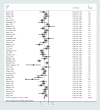Parity and endometrial cancer risk: a meta-analysis of epidemiological studies
- PMID: 26373341
- PMCID: PMC4642705
- DOI: 10.1038/srep14243
Parity and endometrial cancer risk: a meta-analysis of epidemiological studies
Abstract
The association between parity and endometrial cancer risk is inconsistent from observational studies. We aimed to quantitatively assess the relationship by summarizing all relevant epidemiological studies. PubMed (MEDLINE), Embase and Scopus were searched up to February 2015 for eligible case-control studies and prospective studies. Random-effects model was used to pool risk estimations. Ten prospective studies, 35 case-control studies and 1 pooled analysis of 10 cohort and 14 case-control studies including 69681 patients were identified. Pooled analysis revealed that there was a significant inverse association between parity and risk of endometrial cancer (relative risk (RR) for parous versus nulliparous: 0.69, 95% confidence interval (CI) 0.65-0.74; I(2) = 76.9%). By evaluating the number of parity, we identified that parity number of 1, 2 or 3 versus nulliparous demonstrated significant negative association (RR = 0.73, 95% CI 0.64-0.84, I(2) = 88.3%; RR = 0.62, 95% CI 0.53-0.74, I(2) = 92.1%; and RR = 0.68, 95% CI 0.65-0.70, I(2) = 20.0% respectively). The dose-response analysis suggested a nonlinear relationship between the number of parity and endometrial cancer risk. The RR decreased when the number of parity increased. This meta-analysis suggests that parity may be associated with a decreased risk of endometrial cancer. Further studies are warranted to replicate our findings.
Figures



Similar articles
-
Parity and thyroid cancer risk: a meta-analysis of epidemiological studies.Cancer Med. 2016 Apr;5(4):739-52. doi: 10.1002/cam4.604. Epub 2015 Dec 29. Cancer Med. 2016. PMID: 26714593 Free PMC article.
-
Coffee consumption and risk of endometrial cancer: findings from a large up-to-date meta-analysis.Int J Cancer. 2012 Oct 1;131(7):1700-10. doi: 10.1002/ijc.27408. Epub 2012 Jan 31. Int J Cancer. 2012. PMID: 22190017
-
Parity and Cardiovascular Disease Mortality: a Dose-Response Meta-Analysis of Cohort Studies.Sci Rep. 2015 Aug 24;5:13411. doi: 10.1038/srep13411. Sci Rep. 2015. PMID: 26299306 Free PMC article.
-
Alcohol consumption and the risk of endometrial cancer: a meta-analysis.Asia Pac J Clin Nutr. 2011;20(1):125-33. Asia Pac J Clin Nutr. 2011. PMID: 21393120
-
Breastfeeding and the incidence of endometrial cancer: A meta-analysis.Oncotarget. 2015 Nov 10;6(35):38398-409. doi: 10.18632/oncotarget.5049. Oncotarget. 2015. PMID: 26384296 Free PMC article. Review.
Cited by
-
Changing Incidence of Uterine Cancer in Rural Egypt: Possible Impact of Nutritional and Epidemiologic Transitions.J Glob Oncol. 2019 Jul;5:1-7. doi: 10.1200/JGO.18.00255. J Glob Oncol. 2019. PMID: 31365301 Free PMC article.
-
Somatic Mosaicism in Biology and Disease.Annu Rev Physiol. 2022 Feb 10;84:113-133. doi: 10.1146/annurev-physiol-061121-040048. Epub 2021 Oct 12. Annu Rev Physiol. 2022. PMID: 34637327 Free PMC article. Review.
-
Development of a long term, ex vivo, patient-derived explant model of endometrial cancer.PLoS One. 2024 Apr 18;19(4):e0301413. doi: 10.1371/journal.pone.0301413. eCollection 2024. PLoS One. 2024. PMID: 38635728 Free PMC article.
-
A comprehensive analysis of immunotherapy in advanced endometrial cancer (Review).Oncol Lett. 2023 Dec 28;27(2):77. doi: 10.3892/ol.2023.14210. eCollection 2024 Feb. Oncol Lett. 2023. PMID: 38192679 Free PMC article. Review.
-
Cigarette Smoking and Estrogen-Related Cancer.Cancer Epidemiol Biomarkers Prev. 2021 Aug;30(8):1462-1471. doi: 10.1158/1055-9965.EPI-20-1803. Epub 2021 May 14. Cancer Epidemiol Biomarkers Prev. 2021. PMID: 33990391 Free PMC article. Review.
References
-
- Hill H. A. & Austin H. Nutrition and endometrial cancer. Cancer Causes Control 7, 19–32 (1996). - PubMed
-
- Kvale G., Heuch I. & Ursin G. Reproductive factors and risk of cancer of the uterine corpus: a prospective study. Cancer Res 48, 6217–6221 (1988). - PubMed
-
- Fujita M. et al. Smoking, earlier menarche and low parity as independent risk factors for gynecologic cancers in Japanese: a case-control study. Tohoku J Exp Med 216, 297–307 (2008). - PubMed
Publication types
MeSH terms
Grants and funding
LinkOut - more resources
Full Text Sources
Other Literature Sources

